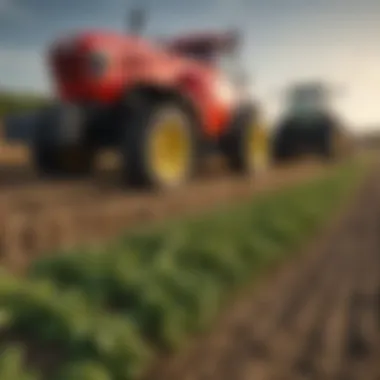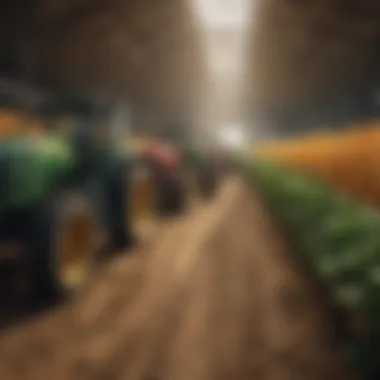Exploring E-commerce Models in Agriculture


Overview of the Topic
Definition and Importance
E-commerce in agriculture refers to the process of buying and selling agricultural products through online platforms. This type of commerce plays a crucial role in modern agriculture by improving access to markets, increasing efficiency, and expanding the range of products available to consumers. Farmers can directly reach consumers without intermediaries, thus optimizing the supply chain.
The importance of e-commerce in agriculture lies in its ability to connect producers with buyers globally. This connection not only boosts sales but also enhances farmers’ understanding of market demands. Ultimately, e-commerce can help in ensuring food security and improving the livelihoods of agricultural producers.
Current Trends
Current trends indicate a significant shift towards digital platforms tailored for agriculture. Farmers increasingly utilize platforms like Amazon, Facebook Marketplace, and specialized agricultural marketplaces to market their products. Another emerging trend is the integration of mobile applications, which allow farmers to manage their sales and inventory efficiently.
- Use of Big Data: Analyzing consumer behavior and preferences enhances marketing strategies.
- Sustainability Focus: Many e-commerce platforms now prioritize eco-friendly products, catering to a growing consumer demand for sustainable options.
- Social Media Marketing: Platforms like Instagram and TikTok increasingly serve as vital tools for product promotion, reaching younger demographics.
"The rise in e-commerce platforms is revolutionizing the agricultural industry, enabling farmers to be more competitive in the market."
Key Techniques and Practices
Step-by-Step Guide
- Market Research: Understand target consumers and their needs by analyzing market trends.
- Choosing the Right Platform: Select an appropriate platform such as Mercado Libre or Alibaba that suits your product type and target audience.
- Creating Quality Listings: Use high-quality images and detailed descriptions to showcase products effectively.
- Pricing Strategy: Establish competitive pricing based on market analysis.
- Promotion: Use social media and search engine optimization to promote products and drive traffic to your listings.
Tools and Equipment Needed
- Computer or Smartphone: Essential for managing e-commerce activities.
- Quality Camera: To take professional photos of products for online listings.
- Inventory Management Software: Helps track stock levels and sales data.
- Payment Processing Solutions: Services like PayPal or Stripe for secure transactions.
Challenges and Solutions
Common Obstacles
Despite the benefits of e-commerce, several challenges exist in the agricultural sector:
- Limited Internet Access: Some farmers, especially in rural areas, may struggle with connectivity.
- Tech Literacy: A lack of digital skills can hinder effective use of e-commerce tools.
- Logistical Issues: Ensuring timely delivery of products can be a daunting task, leading to customer dissatisfaction.
Innovative Solutions
To counter these challenges, several innovative solutions can be implemented:
- Training Programs: Organizations can offer workshops to improve digital literacy among farmers.
- Invest in Infrastructure: Governments and cooperatives should work to improve internet access in rural areas.
- Collaborations with Delivery Services: Partnerships with reliable delivery companies can streamline logistics, ensuring that products reach consumers efficiently.
This comprehensive look into e-commerce in agriculture highlights the multifaceted nature of the industry. By understanding these elements, farmers and agricultural enthusiasts can better navigate the evolving landscape of commerce in their field.
Introducción al Comercio Electrónico
The role of e-commerce in agriculture cannot be understated. It is a transformative force that is reshaping how farmers and consumers interact. With the rise of digital platforms, farmers can reach broader markets, streamlining their operations. Understanding this relationship is vital for those involved in agriculture, as it presents numerous advantages like cost reduction and improved access to resources.
In this section, we will explore the essential elements of e-commerce and its significance within the agricultural sector. The shift from traditional marketing to online sales channels has introduced new opportunities for farmers. Online platforms facilitate transactions, enabling better price comparisons, which can lead to more informed purchasing decisions for consumers.
Moreover, e-commerce allows for effective communication between suppliers and buyers. This enhances transparency in pricing and product quality. The transition to digital sales requires knowledge and adaptability, making it crucial for farmers to be informed about the latest trends in technology. This section will set the groundwork for understanding the various forms of e-commerce in agriculture, outlining what is to come.
Definición de Comercio Electrónico
E-commerce, or electronic commerce, refers to the buying and selling of goods and services via the internet. In agricultural contexts, this can involve various models like B2B, B2C, and C2C. Each model serves different market participants and has unique characteristics relevant to the agricultural supply chain.
E-commerce encompasses numerous activities beyond simple online shopping. Examples include online auctions, direct sales, and subscription services, which provide fresh produce to consumers regularly. Understanding these definitions helps cultivate a clear perspective of how e-commerce can influence agricultural practices.
Historia y Desarrollo
The history of e-commerce dates back to the early days of the internet in the 1990s. Early adopters included booksellers like Amazon, who laid the groundwork for other sectors to follow. The agriculture sector has slowly integrated e-commerce into its operations as technology advanced and internet access became more widespread.
Initially, e-commerce in agriculture was limited to simple transactions through basic websites. With time, platforms like Alibaba and MercadoLibre emerged, offering more sophisticated solutions tailored to the farming industry. These platforms not only facilitate sales but also provide valuable information and a network for farmers, allowing them to sell directly to consumers or engage with other businesses.


As digital technologies continue to evolve, so does the potential for e-commerce in agriculture. Farmers are now utilizing digital tools to analyze market trends, manage logistics, and respond to consumer demands more swiftly. This development reflects a broader trend toward a digitized economy, where data and technology play a key role in shaping industry practices.
Tipos de Comercio Electrónico
E-commerce has fundamentally altered agricultural practices, showing varied models based on interactions among stakeholders. Understanding these models can enhance productivity and market reach for farmers. Each type serves specific needs and offers distinct benefits that cater to different segments of the agricultural market. There are several types of e-commerce, such as B2B, B2C, C2C, and C2B, each playing a significant role in how products are sourced, sold, and distributed in agriculture.
B2B (Business to Business)
Características del B2B
B2B e-commerce involves transactions between businesses rather than individuals. This model is critical for agricultural entities that often rely on bulk transactions with suppliers and distributors.
A key characteristic of B2B is the volume of transactions. Businesses usually make large orders to get discounts, making this model financially appealing. The relationship in B2B transactions is often long-term, with companies seeking reliable partners for inputs like seeds, fertilizers, and machinery.
One distinctive feature is the negotiation process. This adds a layer of complexity and can lead to better pricing and terms for both parties, benefiting the overall cost structure within the agricultural sector. However, it requires a good understanding of market dynamics and the products needed, which can be a hurdle for some new entrants.
Ejemplos en el Sector Agrícola
In the agricultural domain, successful B2B e-commerce examples abound. Companies like Trimble provide precision agriculture technology directly to farmers and agricultural businesses. This connection helps streamline processes involved in farming.
Another example is UPL, a global provider of agricultural solutions that engages in direct transactions with farmers and distributors. This creates an efficient channel for goods. Their ability to offer customized solutions built on long-term partnerships exemplifies the strength of B2B strategies. The potential downside includes the reliance on existing relationships and the risk of market fluctuations that can affect buying decisions.
B2C (Business to Consumer)
Características del B2C
B2C e-commerce centers on businesses selling directly to consumers. It's particularly beneficial in agriculture, where consumers increasingly prefer fresh and local produce.
One prominent characteristic of B2C is the direct interaction with end-users, allowing businesses to receive immediate feedback. This two-way communication enhances customer service and adjustments to the offerings based on consumer preferences. Additionally, the convenience of online shopping attracts consumers, making it a popular choice in today’s fast-paced world.
Casos de Éxito en el Comercio Agrícola
Numerous success stories illustrate B2C effectively in agriculture. Companies like Farmigo have developed user-friendly platforms that allow consumers to order fresh produce directly from local farmers. By cutting out middlemen, they enhance the freshness of the produce and provide better prices for both consumers and farmers.
Another notable example is Blue Apron, which ties consumers directly to meal kits that utilize seasonal produce. This has drawn attention to sustainability in sourcing agricultural products. While these platforms have proven successful, they face challenges such as high competition and constantly changing consumer preferences, requiring them to be adaptive and innovative.
C2C (Consumer to Consumer)
Características del C2C
C2C denotes transactions between consumers, often facilitated by online platforms. This model allows individuals to buy and sell agricultural products among themselves, creating a newer market segment.
The uniqueness of C2C lies in the potential for farmers to reach consumers directly, bypassing traditional distribution channels. This is particularly advantageous for smaller farms with limited market exposure. However, this model may also lead to inconsistencies in quality and pricing, as consumers may not always adhere to standard pricing regulations.
Plataformas Comunes en la Agricultura
Several platforms facilitate C2C agricultural transactions. Websites como Etsy allow local farmers to sell products directly to consumers within a community-oriented framework. Furthermore, Facebook Marketplace has become increasingly popular among farmers for selling surplus products.
These platforms provide local access to goods, enhancing community ties. However, challenges like trust among buyers and sellers can emerge, impacting the effectiveness of these platforms.
C2B (Consumer to Business)
Definición y Aplicaciones
C2B allows consumers to offer products or services to businesses. In agriculture, this means individuals can sell their produce to businesses, potentially generating extra income for them.
This model is beneficial as it enables businesses to source products directly from consumers, enhancing supply chain efficiency. It encourages local sourcing, which is crucial for sustainability efforts within the agricultural sector. However, C2B depends heavily on the willingness of consumers to sell their products, which may not be consistent.
Ejemplos en el Sector Agrícola
An illustrative example of C2B in agriculture is Farmdrop. This platform allows consumers to sell their excess produce to local businesses. The design taps into the growing desire for fresh, local produce.
Another example is the platform called LocalHarvest. It connects local farmers with consumers who want to sell their produce or handmade goods directly. This interaction fosters community and decreases reliance on large-scale agricultural systems. However, scalability might be limited because consumers' production capacity can be both unpredictable and vary drastically based on seasons.


In summation, understanding the types of e-commerce in agriculture clarifies how farmers and businesses can optimize their operations while adapting to a digital world.
Perspectivas de Mercado en el Comercio Electrónico Agrícola
The market perspectives in agricultural e-commerce are crucial not only for understanding current trends, but also for anticipating future developments. As technology integrates more deeply into agricultural practices, the need for farmers to adapt to these changes is clear. This section addresses the pressing importance of e-commerce in this sector and highlights its influence on profitability and sustainability.
Crecimiento del Comercio Electrónico en Agricultura
The growth of e-commerce in agriculture has seen a remarkable increase in recent years. Statistics indicate a significant uptick in online sales platforms dedicated to agricultural products. As farmers utilize online marketplaces, they gain access to broader markets, directly impacting their income. Enhanced connectivity allows them to reach consumers nationwide, or even globally.
Factors contributing to this growth include:
- Increased Internet Access: More rural areas are gaining reliable internet access, enabling farmers to participate in e-commerce.
- Demand for Fresh Products: Consumers are increasingly seeking fresh, locally sourced products, which farmers can provide directly.
- Efficiency in Transactions: E-commerce offers streamlined processes for transactions, making it convenient for farmers to sell their goods.
The growing embrace of digital tools is transforming the agricultural landscape.
Impacto de la Digitalización en la Agricultura
Digital transformation in agriculture has multifaceted consequences. It has reshaped various aspects of the agricultural supply chain. Farmers who adopt digital strategies not only improve their operations but also enhance their decision-making processes.
Digitalization offers:
- Data-Driven Insights: Farmers can analyze market trends and customer preferences more effectively.
- Improved Resource Management: Precision agriculture tools allow for better crop management and optimal resource use.
- Enhanced Communication: Digital platforms facilitate better communication between buyers and sellers, minimizing misunderstandings and increasing trust in transactions.
"The integration of technology in agriculture is not just a trend, but a necessary evolution for future sustainability."
Beneficios del Comercio Electrónico para Agricultores
The role of e-commerce in agriculture is significant. It offers various benefits that can greatly enhance the way farmers conduct business. Understanding these benefits is crucial for any farmer looking to adapt to the digital landscape. The main advantages include access to new markets, efficiency in distribution, and an improved customer experience.
Acceso a Nuevos Mercados
One of the profound benefits of e-commerce is access to new markets. Farmers no longer need to limit themselves to local buyers. Online platforms allow them to reach potential customers globally. This opportunity can lead to increased sales and better prices for their products. Furthermore, niche markets for organic or specialty goods become more reachable. As farmers adopt e-commerce strategies, they expand their customer base significantly, which can lead to enhanced revenue.
Eficiencia en la Distribución
E-commerce also brings about efficiency in distribution. Traditional distribution can be complex, with many intermediaries involved. E-commerce platforms simplify this process. Farmers can sell directly to consumers, minimizing the steps needed to deliver products. This leads to a reduction in costs associated with logistics. Additionally, digital tools can optimize the supply chain management, ensuring timely delivery of goods. Technology also provides insights into customer demand, helping farmers manage inventory better.
Mejora en la Experiencia del Cliente
Customer experience is another key benefit of e-commerce in agriculture. Online shopping allows consumers to browse products conveniently. They can compare prices, read reviews, and make informed purchasing decisions. This creates a more satisfying buying experience. Also, e-commerce platforms often provide updates regarding the status of orders, which improves communication. Engaging with customers through feedback can enhance relationships, leading to repeat business.
"The rise of e-commerce in agriculture is not just a trend; it is a fundamental shift in how food is marketed and sold."
Desafíos del Comercio Electrónico en el Sector Agrícola
El comercio electrónico en el sector agrícola ofrece numerosas oportunidades, pero también presenta varios desafíos que deben ser considerados. Es crucial entender estas dificultades para que los agricultores y empresas puedan prepararse y adaptarse a un entorno de comercio cada vez más digital. Los desafíos abarcan problemas logísticos, falta de conocimiento técnico, y cuestiones de confianza y seguridad en las transacciones. Superar estos obstáculos es esencial para maximizar los beneficios del comercio electrónico en la agricultura.
Problemas Logísticos
Los problemas logísticos son uno de los mayores desafíos que enfrentan los agricultores al adaptar su negocio al comercio electrónico. En un sector donde la frescura y la calidad de los productos son fundamentales, asegurar que los productos lleguen a tiempo y en óptimas condiciones es vital. Los agricultores necesitan establecer sistemas de distribución eficientes que puedan manejar el almacenamiento y la entrega de productos perecederos.
Otro aspecto logístico crítico es la infraestructura. En muchas áreas rurales, la inexistencia de una red de transporte eficiente puede limitar la capacidad de los agricultores para acceder a mercados más amplios. Adaptar la logística a las demandas del comercio electrónico requiere inversiones significativas en transporte y almacenamiento, y esto puede ser un impedimento para muchas pequeñas explotaciones agrícolas.
Falta de Conocimiento Técnico
La transición al comercio electrónico puede ser desafiante debido a la falta de conocimiento técnico entre los agricultores. No todos los productores están familiarizados con las plataformas digitales y las herramientas necesarias para gestionar sus ventas en línea. Esto incluye el uso de software para administrar inventarios, procesar pagos y mejorar el servicio al cliente.
La necesidad de capacitación es evidente. Una educación adecuada y recursos accesibles pueden empoderar a los agricultores. Sin embargo, muchas veces estas oportunidades de formación no están disponibles. Por lo tanto, es vital unir esfuerzos con organizaciones que ofrezcan talleres o cursos en línea sobre comercio electrónico y tecnología agrícola.
Confianza y Seguridad en las Transacciones


La confianza es un fundamento esencial en el comercio electrónico. Los agricultores deben sentirse seguros al realizar transacciones en línea y al compartir su información personal y financiera. La falta de confianza en las plataformas de pago o en la protección de datos puede llevar a una resistencia al uso del comercio electrónico.
Además, los fraudes en línea son una preocupación constante. Implementar medidas de seguridad robustas es fundamental para proteger tanto a los vendedores como a los compradores. Utilizar sistemas de pago seguros y encriptar la información sensible puede ayudar a mitigar estos riesgos.
En resumen, aunque el comercio electrónico en la agricultura proporciona ventajas significativas, hay que enfrentar estos desafíos con seriedad. Comprender y abordar los problemas logísticos, incrementar el conocimiento técnico y fomentar un entorno seguro para las transacciones son pasos importantes hacia el éxito en este nuevo panorama de negocio.
Impacto Ambiental del Comercio Electrónico
E-commerce in agriculture has implications that extend beyond just financial transactions. It becomes crucial to examine its environmental impact as the sector adapts to new marketplaces and digital technologies. Understanding the relationship between commerce and the environment could inform better practices among farmers and corporations alike.
Sostenibilidad en las Prácticas de Comercio Electrónico
Sustainability in e-commerce practices focuses on reducing the ecological footprint of online agricultural transactions. This includes minimizing waste, reducing carbon emissions, and utilizing sustainable energy sources.
- Packing Materials: Many companies are shifting to biodegradable packaging options rather than conventional plastics. This reduces landfill waste and supports a circular economy.
- Efficient Logistics: Implementing advanced logistics solutions can decrease travel distances for delivery trucks, leading to lower emissions. Using data analytics, firms can optimize routes and delivery schedules.
- Digital Platforms: The emergence of online sales platforms allows farmers to connect directly with consumers, reducing the need for intermediaries. Fewer intermediaries can lead to lower energy consumption associated with product handling and transportation.
Consideraciones de Huella de Carbono
The carbon footprint of e-commerce in agriculture can be significant. Every stage of the e-commerce cycle contributes to this footprint, from production to delivery. Evaluating these components is necessary to identify areas for improvement.
- Transportation Emissions: Transportation often accounts for the largest portion of carbon emissions in e-commerce. Using local distribution networks can mitigate this issue.
- Energy Utilization: Websites and digital platforms consume energy. Opting for data centers that utilize renewable energy can lessen their impact.
- Consumer Behavior: Awareness of environmental issues prompts consumers to prefer eco-friendly products. Businesses that emphasize their commitment to sustainable practices may benefit from increased customer loyalty.
"Environmental consciousness in e-commerce can serve not only as a responsibility but also as a competitive advantage in today's market."
In summary, the environmental impact of e-commerce in agriculture is an important topic. Sustainable practices can significantly reduce the negative consequences of these emerging commerce models. By addressing factors like carbon footprints and waste management, stakeholders can work towards a greener future.
Tendencias Emergentes en Comercio Electrónico Agrícola
The emergence of new trends in e-commerce is reshaping the agricultural sector. These trends are important because they reveal how technology can be harnessed for efficiency and sustainability. As farmers and businesses adapt to these innovations, it becomes crucial to understand their implications and opportunities.
Uso de Tecnologías Avanzadas
In this age of rapid advancement, technologies like Artificial Intelligence (AI) and Blockchain present significant opportunities for improvement in agricultural e-commerce.
Inteligencia Artificial
Artificial Intelligence is revolutionizing various sectors, including agriculture. One specific aspect of AI in this context is data analysis. By analyzing big data, AI can help farmers make better decisions based on patterns and trends.
A key characteristic of AI is its ability to learn and adapt over time. This makes it a popular choice for e-commerce applications in agriculture. The unique feature of AI lies in its predictive capabilities. This advancement allows farmers to anticipate market changes or crop yields, leading to more informed decision-making.
The advantages of AI in this article are manifold. From optimizing supply chains to personalizing customer experiences, AI enhances every aspect of agricultural e-commerce. However, there are also disadvantages. Implementation costs and the need for technical know-how can pose challenges for many farmers.
Blockchain
Blockchain technology also has a distinct role in e-commerce for agriculture. Its core aspect is transparency in transactions. This means that every transaction can be tracked, which builds trust among consumers. A key characteristic of blockchain is its security; the decentralized nature of blockchain makes it resistant to fraud.
The unique feature of blockchain is its ability to ensure traceability. In agriculture, consumers increasingly want to know where their food comes from. Blockchain efficiently records every step of the product's journey, from farm to table.
The advantages of blockchain technology include enhanced consumer trust and improved supply chain efficiency. Yet, disadvantages encompass the complexity and costs associated with network setup, which can be barriers for smaller operations.
Cambio en Comportamientos del Consumidor
Changes in consumer behavior are crucial to understanding the future of agricultural e-commerce. The rise of online shopping is shifting how consumers perceive agricultural products. Increasing awareness about sustainability influences buying decisions. Many consumers prefer to support local farmers and eco-friendly products.
Farmers must adapt to these new preferences. Engaging effectively with consumers through digital channels, such as social media or dedicated e-commerce platforms, can create added value. This adaptability is not just about selling but about building a community and fostering deeper connections with consumers.
Culminationes y Futuro del Comercio Electrónico en Agricultura
The exploration of electronic commerce in agriculture reveals crucial insights into its transformative power. The importance of understanding the future of e-commerce in this sector cannot be understated. Technology continues to evolve, and its implications for agricultural practices are profound.
E-commerce provides new opportunities for farmers, enhancing efficiency and access to wider markets. As we examine the future, several key elements emerge:
- Adoption of Advanced Technologies: The rise of tools such as Artificial Intelligence and Blockchain will likely further streamline processes. Farmers can benefit from improved supply chain transparency, which can lead to better product tracking and quality assurance.
- Consumer Behavior Shifts: With the increasing prevalence of online shopping, understanding consumer preferences becomes vital. Farmers and businesses that adapt to these changes are better positioned to thrive. The trend toward convenience and sustainability among consumers means agricultural producers must respond accordingly.
- Focus on Sustainability: Future e-commerce models in agriculture will need to prioritize sustainable practices. A growing awareness of environmental impact among consumers emphasizes the need for farmers to integrate eco-friendly methods.
"The intersection of technology and agriculture will shape not only how products are sold but also how food is produced and distributed."
The benefits of embracing e-commerce in agriculture include:
- Increased Market Reach: By utilizing online platforms, farmers can connect with consumers directly, thus reducing reliance on traditional distribution channels.
- Cost Efficiency: E-commerce can lead to lower operational costs. Digital marketing eliminates some of the expenses associated with physical storefronts.
- Enhanced Customer Relations: Online platforms enable better interaction with consumers. Feedback and engagement through digital means create opportunities for improvement and innovation.
However, it is essential to consider challenges ahead. Issues such as digital literacy and maintaining cybersecurity will need careful attention. Farmers may require training and support to navigate the complexities of digital platforms. Additionally, fostering trust in online transactions will be pivotal.



